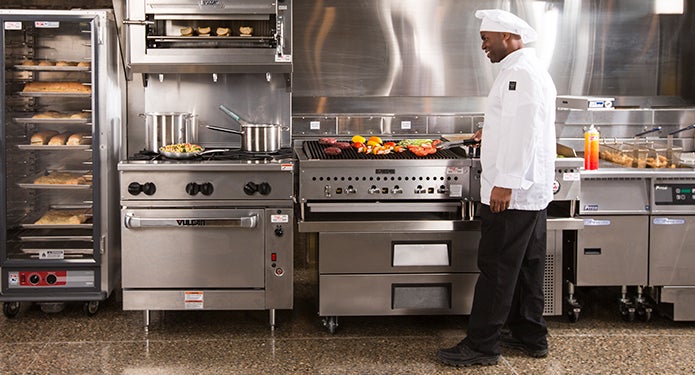Products designed for efficiency can speed up foodservice and have a big impact on labour savings.
Unlike fashion designers, foodservice equipment companies don’t come out with a lineup of ovens or deep-fryers in new colours every season. Many foodservice products and tools have been available for decades. But in the face of minimum wage increases and labour challenges, now is a good time to take a look at equipment that can improve kitchen speed, efficiency and costs.
There are some new or updated products out there, but the back of the house doesn’t like to change much, says Nick Dimson of United Restaurant Supplies (URS) in Ontario. Reasons include cost, training and changing the way food is made can impact the menu and customer satisfaction.
“What’s important in this business are the things diners see, touch and put in their mouth,” he notes. “The plate, fork and food are important; the kitchen equipment is less important.”
Despite that viewpoint, equipment experts and chefs point to six options that can make a difference in food consistency and quality, as well as time and cost savings.
1. The combi-oven
Although they are about as expensive as a luxury car, they can provide huge cost savings as long as they are right for your business, Dimson says. This oven features convection cooking, steam injection and microwave heating that work together to cook foods faster and more consistently.
Hotels, caterers, banquet halls and golf courses—places that need to feed a lot of people all at once—are great candidates to use these ovens. “They can be loaded up with steaks, chicken breasts or even grilled cheese sandwiches, push a pre-programmed button and they will be cooked consistently every time.”
This oven pays you back in a couple of ways, he notes. Once an oven is loaded and cooking, it frees up a worker to handle other tasks. For multi-unit operators, you may no longer need a chef at each location. One chef can create recipes and program them into a USB stick that’s sent to each location. This reduces employee costs as lower-paid staff can punch the oven button and produce chef-quality results.
2. Turbochef or Merrychef ovens
These are much less expensive versions of the combi-oven, and not as suitable for large batches or raw meats. But if you run a bar, pub, lunch counter or midsize casual restaurant, these ovens are space savers that cut cooking time and get food to the table faster. For example, Gordon Food Service Chef Jason Kalinowski points out that a convection oven can take 10 minutes to cook a stacked up plate of nachos. A Turbochef or Merrychef can do the job in a minute.
“We worked with an operator who implemented this technology and it freed up space in the kitchen, it got food to the table faster and, on busy nights, it increased table turns,” Kalinowski says.
These ovens are similar to those used at sub sandwich shops. Dimson says they apply radiant heat, hot air impingement and side-launched microwaves to toast, crisp and brown food. They cook pizza in three minutes, french fries in two. They also store 250 programmed recipes, can be used with metal pans and are cool to the touch for kitchen safety.
3. Conveyor ovens
With the ability to increase or decrease speeds to achieve different results, Kalinowski points to its all-in-one capabilities. It saves the cost and space of having multiple pieces of equipment, such as a convection oven, microwave or broiler.
4. Deep-fryers
Fried food is a customer favourite, and the experts say it’s worthwhile to consider equipment that can save money over time. Dimson points to smaller fryers that use less oil. They may cost more up front, but because they use less oil, you save on oil volume and by not having to heat as much oil to fry foods.
Kalinowski suggests a self-filtering fryer. This delivers longer oil shelf-life, plus it saves the time of having someone standing over a hot fryer trying to clean it out after a busy day of service.
5. Induction cooking
Induction cooking offers energy savings at the same time it minimizes heat in the kitchen, according to Tom Lang at URS. Induction cooktops heat quickly and provide precise temperature control for holding food.
6. Small equipment
Don’t overlook the value of slicers, food processors, immersion blenders, mixers and, if you are high-volume pizzeria, a sheet roller for dough. “All of these take away some of the manual labour,” says URS Sales Representative Richard Kirkpatrick. “Any kitchen efficiency is relevant to saving time.”
Kalinowski points to three simple tools he thinks every kitchen should employ to save time and money:
Portion scoops. They eliminate the eyeballing that happens in foodservice, maximizing ingredient use and creating recipe consistency.
Scales. For those things that can’t be scooped, a scale delivers the same kind of product-usage consistency.
Mandoline. Use it to increase slicing speed and maximize vegetable and fruit yield.










